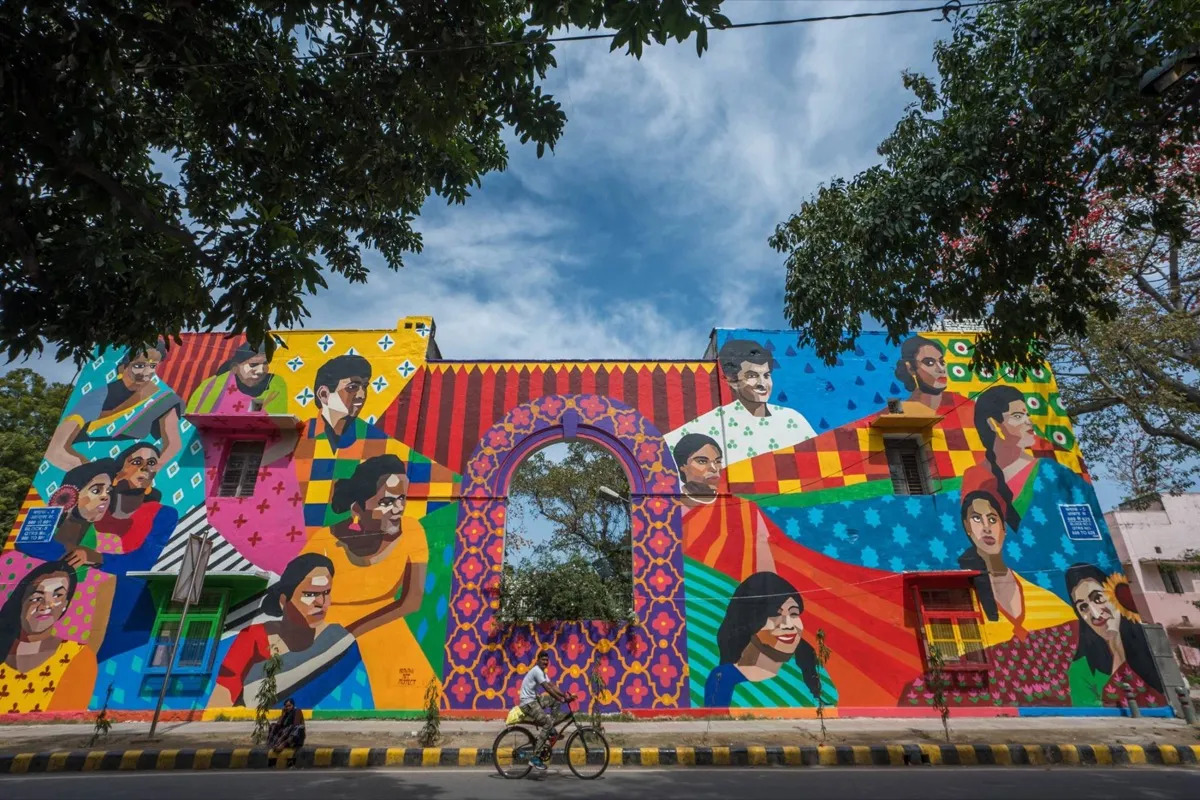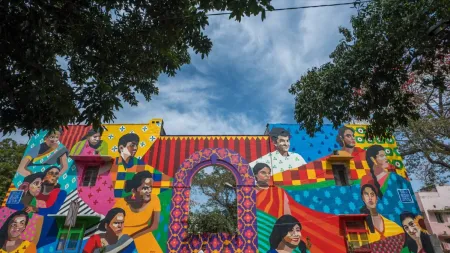
A decade ago, India’s top court ruled that transgender people should be treated as a third category of gender. While that decision would seem to indicate a progressiveness in India, the lived experience for transgender people there differs greatly. Across the country, they are often derided and disparaged. Many are often turned out onto the streets by prejudiced families who fail to understand them. In public spaces, from streets and parks to mass transit, transgender and gender nonconforming persons often face persistent discrimination and outright exclusion.
A Bengaluru-based arts collective, however, has been working to remediate this history of bias and discrimination by encouraging transgender people to forge a connection with the public through art.
The Aravani Art Project, so named after a term used for the trans community in the southern state of Tamil Nadu, helps transgender people voice expressions through visual art.
The seeds of the project were sown in 2014, when a filmmaker making a documentary on the transgender community approached founder Poornima Sukumar.
“It took a couple of years to finish the documentary, and, by the end, I was disgusted by how society turned a blind eye to the transgender community, a thriving pool of beautiful human beings seen as anything but that,” Sukumar told ARTnews.
Two years later, Sukumar launched the project with the aim of bringing the transgender community into the limelight. In the eight years since, the art collective has developed eye-catching and vibrant public art installations, graphic novels, comics, paintings, digital projects, and paintings, as well events like drama walks and workshops that showcase the life and challenges of the community.
“Transgender people are subjected to so much scrutiny and phobia in society. The art project is designed to create a safe space by painting walls to reflect our conversations with the community,” she said.
Stigma and discrimination still dog the community, according to Sukumar, but participants report that working together to paint public spaces makes them feel “more fearless and creates a sense of togetherness.” Meanwhile, bystanders appear to be open to listening, learning, and observing what the artists have to say through their art, encouraging acceptance and inclusiveness toward all genders.

The collective has worked in Mumbai, Delhi, Kolkata, Bengaluru, and Pune, as well as at Facebook headquarters in Menlo Park, creating murals that imbue the walls with joie de vivre and dynamism. The commissions that Aravani takes on have helped many participants earn a livelihood through art, as well as reclaim spaces that have historically excluded them.
Shanthi Muniswamy, one of the project’s lead artists, was working as a disc jockey at a small community-run radio station prior to joining Aravani in 2016.
“I had no training so every wall—paint and brushes in hand—was a learning experience,” she told ARTnews, adding that the journey has helped her realise the therapeutic power of art while helping change perceptions, “one person at a time.”
Typically, the artworks are created in public spaces where transgender and marginalised people go through discrimination, sometimes even violence. Creating art in public has allowed “mainstream” people to get a closer look at the community, created space for conversations and understanding to take place.
“When we are making murals, many people come and talk to us to know more. The art is like a bridge between ‘us’ and ‘them’; it has helped forge organic connections,” Muniswamy said.
Aravani’s first project, completed in early 2016, was a mural installation in a busy Bengaluru market. The wall used to create the mural stood in for a “judgmental society” while the artwork is covered as with a smoke screen, camouflaging people to create a sense of inclusivity for the transgender community.
“”Art is a powerful tool to start a movement and bring about slow change. We are creating space in the art world and society at large by reclaiming spaces otherwise very influenced by class,” Sukumar said. Claiming an identity as an artist is important as is the fact that “gender comes after what they love doing the most,” she added.
Quite a few projects portray a transgender person, along with motifs from particular local cultures. A project Aravani completed in Pune depicts the Paithani, a silk sari known for its rich colours, floral and bird-inspired motifs, and embroidered gold or silver borders. Meanwhile, in a public mural in Chennai, the jasmine flower takes centre stage, as the busy metropolis is a place where women still stop to take in the fragrance of the mallipoo (jasmine) before stringing flowers through their hair.
Apart from focusing on the lives and stories of transgender people, the artwork is influenced by everyday life, people, and patterns; it focuses on the many extraordinary sights we can see in the ordinary—small glimpses of affection, kindness, laughter, joy, and mystery.
Karnika Bai, a lead artist at Aravani and the only one based in Jaipur, joined the collective in 2017 after seeing Aravani painters at work on a mural in a new metro station.
“Till then, despite being educated, I had no job. I worked as a sex worker and was often angry at my lot, at why I could not get a job just because I was trans,” she told ARTnews.
Aravani “helped turn my life around,” Bai said, adding that she has now developed the skills and reputation to take on work independently from non-profits or public awareness campaigns, like Swachh Bharat, a nationwide effort to make all village open defecation-free.
Challenges for transgender people are reducing across India because of rising awareness, according to Sukumar, but every day is still often fraught with difficult situations.

According to a 2018 National Human Rights Commission study, half the transgender population in India has never attended school. A whopping 92 percent are deprived of the right to participate in any form of economic activity, with qualified people often turned away from job opportunities. A staggering 99 percent of transgenders have suffered social rejection on more than one occasion.
“There can be demeaning circumstances in public transportation, workplaces, interactions and more. However, the coverage our project has received has made it easier for people to recognise members; it has also made them confident so they can voice concerns in public,” Sukumar said.
Over the years, Aravani has collaborated with brands like Uber, Wingreens World, and Walkers & Co. Aravani’s most recent collaboration, with Walkers & Co, focuses on themes of how resilience and empowerment lead to collective progress. “For the first time we worked on huge cloth collages which depicted community, intersectionality, our oneness with nature, importance of togetherness, colours, flowers and birds. All this amalgamated into huge pieces of artwork,” Sukumar said.
The biggest challenged, according to Sukumar, is finding enough work to sustain the entire collective. Currently, Aravani has 30 transgender members from Bangalore, Chennai, Mumbai, and Delhi, as well around 10 cisgender members.
Muniswamy, like Bai, has been able to find art commissions independent from Aravani, in particular, working on the makeover of Jawaharlal Nehru Stadium in Chennai for Khelo India, a programme that aims to revive the sports culture in India.
And, while livelihoods are no doubt important, the biggest impact may be one the shift in perceptions.
“Twenty-one years ago, I was ostracised by my family, Muniswamy said. “Today, my family and friends have my back. Last Diwali, my mother gave me a kurti [a garment traditionally worn by women in India]. That, to me, signalled complete acceptance.”
Blockchain Provenance Tracking Promises More Than Eliminating Forgeries and Risk From the Art Market
Inflamed by the War in Gaza, Germany’s Art Scene Is Tearing Itself Apart

Putter’s Paradise: The $39 Million Pebble Beach Estate Wants to Help You Sharpen Your Short Game

The Worst Dressed Stars in CMT Awards History

Best fitness apps for Apple Watch and iPhone

Caitlin Clark Effect Pushes WNBA Champs to Larger Vegas Venue


